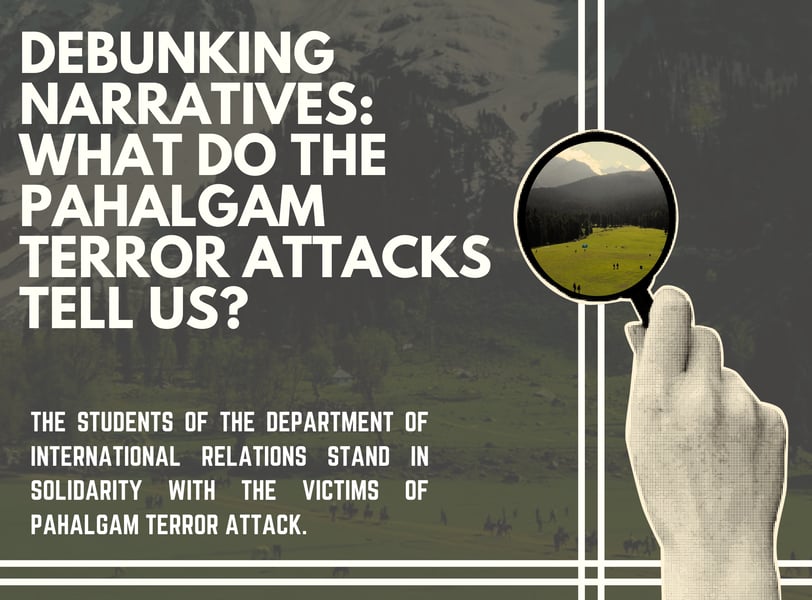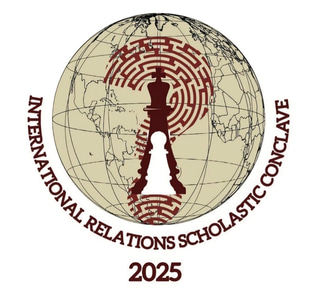DEBUNKING NARRATIVES: What do the Pahalgam Terror Attacks Tell Us?
The press was to serve the governed, not the governers" - Hugo Black
Sneha Mitra
4/29/20255 min read


The terror attacks of Pahalgam are a quintessential example of how lapses of the ruling government are often only shown as incidents of “terrorism” inciting communal hatred amongst the general population whilst the government overlooks its accountability.
THE “TERROR” ANGLE IN PAHALGAM ATTACKS
The lack of a widely accepted definition of terrorism is arguably the largest issue plaguing political scientists when it comes to addressing the challenges posed by terrorism. States continue to have significant discretion over national definitions of terrorism in the absence of an established definition, which leads to varying interpretations of counterterrorism legislation.
In addition to highlighting the fragility of the definition of terrorism, the Pahalgam terrorist assaults also highlight the media's colossal role in inciting communal sentiments in the name of nationalism. In addition to this, the Pahalgam attacks serve as a terrible reminder of how blood has been on the hands of one of the world's most spectacular landscapes (Pahalgam is known as "mini Switzerland") since the state's founding. It brings to mind Kashmir's past as one of the most militarized and tense areas in the Global South, as well as how both the proclaiming nations, India and Pakistan, have consistently viewed Kashmir as its property rather than acknowledging and meeting the needs and demands of the Kashmiri people.
HISTORY OF BLOODSHED
To understand the spine-chilling attacks at Pahalgam, it is important to understand Kashmir’s history of violence and extremism. A state torn between the Since India's partition and the creation of Pakistan in 1947, the nuclear-armed neighbours have fought two wars over the Muslim-majority territory, which both claim in full but control in part. Till today, it remains one of the most militarised zones in the world.
The following is the timeline highlighting key dates in Kashmir’s history:
1947-8 - The Maharaja of Kashmir signs a treaty of accession with India after a Pakistani tribal army attacks. War breaks out between India and Pakistan over the region.
1949 - Kashmir is partitioned between India and Pakistan, with a ceasefire line agreed.
1962 - China defeats India in a brief war in a dispute over the Aksai Chin border area.
1965 - Second Indo-Pakistan war over Kashmir ends in a ceasefire.
Rise of Kashmiri nationalism: Jammu Kashmir Liberation Front is founded with the aim of forming an independent state through the reunification of Indian-administered and Pakistan-administered Kashmir.
1972 - Simla Agreement: India and Pakistan formalise the ceasefire line as the Line of Control as part of new resolve to negotiate differences after their war which ended in Bangladesh splitting from Pakistan.
1980-90s - Kashmir insurgency: Discontent over Indian rule leads to armed resistance, mass protests and a rise in Pakistan-backed militant groups. Ten of thousands of people are killed.
1999 - India and Pakistan engage in a brief conflict after militants cross the Line of Control into the Indian-administered district of Kargil.
2008 - India and Pakistan open trade route across the Line of Control for the first time in six decades.
2010 - Anti-India protests in Indian-administered Kashmir in which over 100 youths are killed.
2015 - Political watershed: Elections in Jammu and Kashmir see India's ruling Hindu nationalist BJP party emerge as a major political player in the region for the first time when it forms part of a coalition government with the regional Muslim People's Democratic Party.
2019 - Indian government strips Jammu and Kashmir state of the special status that gave it significant autonomy.
ROLE OF MEDIA
The Pahalgam attacks not only demonstrate the state's blatant incompetence, but they also reveal how the media feeds jingoistic sentiments in the ordinary populace. In recent days, the state-run media has done everything it can to promote enmity between communities under the guise of "nationalism" by conflating the terms "terrorism" and "Islam." It has failed to not only commemorate the numerous lives that were lost as a result of the militant attacks in the area but also represent the voices of Kashmir, who have called for a free and independent state since the 1980s. Instead of taking accountability, the government chose to blame the “rough terrain” of the region for its failure to deploy forces on time. The media chose to advocate for the government which shifted the blame to Lashkar-e-Taiba and Pakistan instead of taking accountability and accepting that it has failed to establish democracy in Kashmir.
Moreover, it has also given the state-controlled media an opportunity to reinforce the ruling government’s narrative, “Hindu khatre mein hai! (Hindus are in danger!)” even though the terror attacks were not attacks on Hinduism but attempts of insurgent militant groups to establish an independent Kashmir.
RESPONSE OF THE BHAJPA GOVERNMENT
PM Modi, while addressing a public rally in the Madhubani district of Bihar, emphatically said that those responsible for the “terrorist attack and their conspirators will be punished beyond their imagination”. “They will be punished”, he reiterated. In retaliation to the attacks, the NDA government has decided to suspend the historic 1960 Indus Valley Treaty, which had previously survived four wars, decades of cross-border terrorism and a long history of antagonism between the two countries. In response, the Pakistani government has rejected India’s decision saying that any stopping or diversion of the flow of water belonging to Pakistan under the pact will be seen as an “act of war” and responded to with “full force.”
In a closed all-party meeting, officials from the Home Ministry and the Intelligence Bureau informed that there was no police permission to open the Baisaran meadow where the incident occurred. Leader of Opposition Rahul Gandhi has already remarked about the “glaring security failures” of the ruling government. Objecting to comparative figures on casualties and terror attacks given in the presentation by the Home Ministry, Mr. Gandhi reportedly said that instead of admitting that there was a dramatic security failure the government gave a long lecture on its achievements in the past ten years and plans for the next ten years.
The two countries have already fought wars over Kashmir in 1947-48 and 1965. They formalised the original ceasefire line as the Line of Control in the Simla Agreement, but this did not prevent further clashes in 1999 on the Siachen Glacier, which is beyond the Line of Control. India and Pakistan came close to war again in 2002. The situation was further complicated by an Islamist-led Anti-India insurgency that broke out in 1989 with militant violence claiming the lives of thousands since then.
The response of the BJP government not only overlooks its own failure in upholding the justification it had given during the abrogation of Article 370 in 2019 but shows its negligence towards the growing insurgency in the region and its failure to address the demands of Kashmiris to have an autonomous Kashmir. Revoking J&K’s semi-autonomous constitutional status and splitting it between two federally controlled territories, Modi’s government hailed Kashmir’s “normalisation” as a political triumph saying that firm action had resolved the separatist issue and how Kashmir could be “open for business” for civilians to witness the region’s beauty. However, this massive security failure not only reflects on the government’s greed but also punctures the government’s claims that revocation of Article 370 has led to a decline of separatist violence in the region.
CONCLUSION
The Pahalgam attacks show us how lack of information as well as spread of disinformation can lead to superfluous narratives. It has proved to us how easy it is to pit one community against another when the government refuses to take accountability for its own actions. It has shown us how violence supersedes religion and that it is the entire humankind that suffers from the terrors of war, not ‘Hindu’, not ‘Muslim.’
